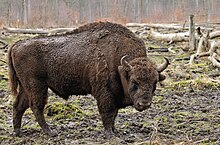Bisons
|
Bison Temporal range: 2–0 Ma Early – Recent |
|
|---|---|
 |
|
|
American bison (Bison bison) |
|
 |
|
|
European bison (Bison bonasus) |
|
| Scientific classification | |
| Kingdom: | Animalia |
| Phylum: | Chordata |
| Class: | Mammalia |
| Order: | Artiodactyla |
| Family: | Bovidae |
| Subfamily: | Bovinae |
| Tribe: | Bovini |
| Genus: |
Bison Hamilton Smith, 1827 |
| Species | |
|
B. bison |
|
| Nutritional value per 100 g (3.5 oz) | |
|---|---|
| Energy | 179 kcal (750 kJ) |
|
0.00 g
|
|
| Sugars | 0 g |
| Dietary fiber | 0 g |
|
8.62 g
|
|
| Saturated | 3.489 g |
| Monounsaturated | 3.293g |
| Polyunsaturated | 0.402 g |
|
25.45 g
|
|
| Vitamins | |
| Thiamine (B1) |
(12%)
0.139 mg |
| Riboflavin (B2) |
(22%)
0.264 mg |
| Niacin (B3) |
(40%)
5.966 mg |
| Vitamin B6 |
(31%)
0.401 mg |
| Folate (B9) |
(4%)
16 μg |
| Vitamin B12 |
(102%)
2.44 μg |
| Vitamin D |
(0%)
0 IU |
| Vitamin E |
(1%)
0.20 mg |
| Vitamin K |
(1%)
1.3 μg |
| Minerals | |
| Calcium |
(1%)
14 mg |
| Iron |
(25%)
3.19 mg |
| Magnesium |
(6%)
23 mg |
| Phosphorus |
(30%)
213 mg |
| Potassium |
(8%)
353 mg |
| Sodium |
(5%)
76 mg |
| Zinc |
(56%)
5.34 mg |
|
|
|
|
|
| Percentages are roughly approximated using US recommendations for adults. Source: USDA Nutrient Database |
|
B. bison
B. bonasus
†B. antiquus
†B. latifrons
†B. occidentalis
†B. palaeosinensis
†B. priscus
†B.schoetensacki
Bison are large, even-toed ungulates in the genus Bison within the subfamily Bovinae.
Two extant and six extinct species are recognised. Of the six extinct species, five went extinct in the Quaternary extinction event. Bison palaeosinensis evolved in the in South Asia, and was the evolutionary ancestor of B. priscus (steppe bison), which was the ancestor of all other Bison species. From 2 MYA to 6,000 BC, steppe bison ranged across the mammoth steppe, inhabiting Europe and northern Asia with B. schoetensacki (woodland bison), and North America with B. antiquus, B. latifrons, and B. occidentalis. The last species to go extinct, B. occidentalis, was succeeded at 3,000 BC by B. bison.
Of the two surviving species, the American bison, B. bison, found only in North America, is the more numerous. Although generally known as a buffalo in North America, it is only distantly related to the true buffalo. The North American species is composed of two subspecies, the Plains bison, B. b. bison, and the Wood bison, B. b. athabascae, which is the namesake of Wood Buffalo National Park in Canada. A third subspecies, the Eastern Woodland Bison (B. b. pennsylvanicus) is no longer considered a valid taxon, being a junior synonym of B. b. bison. References to "Woods Bison" or "Wood Bison" from the eastern United States confusingly refer to this subspecies, not B. b. athabascae, which was not found in the region. The European bison, B. bonasus, or wisent, is found in Europe and the Caucasus, reintroduced after being extinct in the wild.
...
Wikipedia
